Rolls Royce’s ERP Implementation - Report
VerifiedAdded on 2021/06/18
|19
|4191
|655
AI Summary
Contribute Materials
Your contribution can guide someone’s learning journey. Share your
documents today.
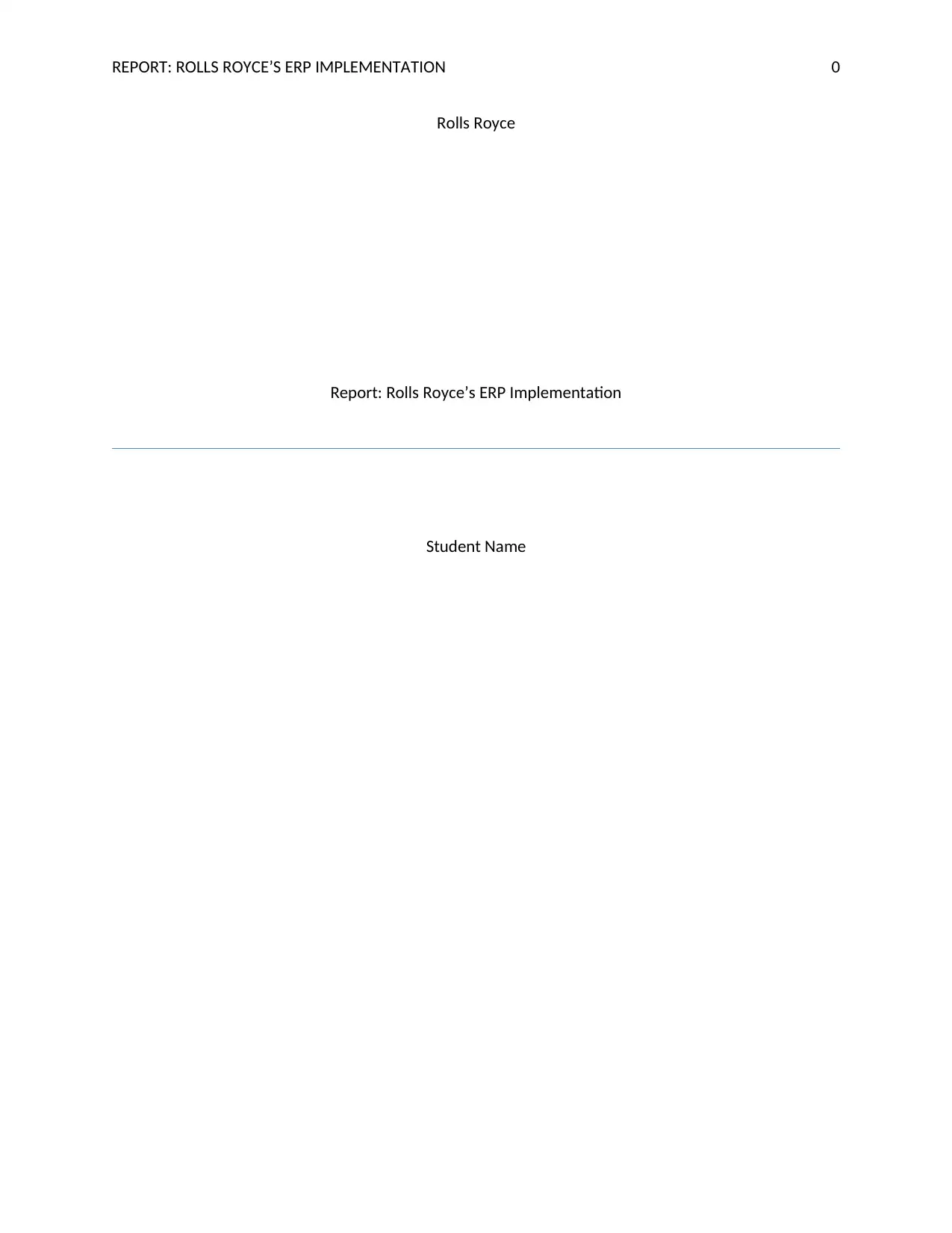
REPORT: ROLLS ROYCE’S ERP IMPLEMENTATION 0
Rolls Royce
Report: Rolls Royce’s ERP Implementation
Student Name
Rolls Royce
Report: Rolls Royce’s ERP Implementation
Student Name
Secure Best Marks with AI Grader
Need help grading? Try our AI Grader for instant feedback on your assignments.
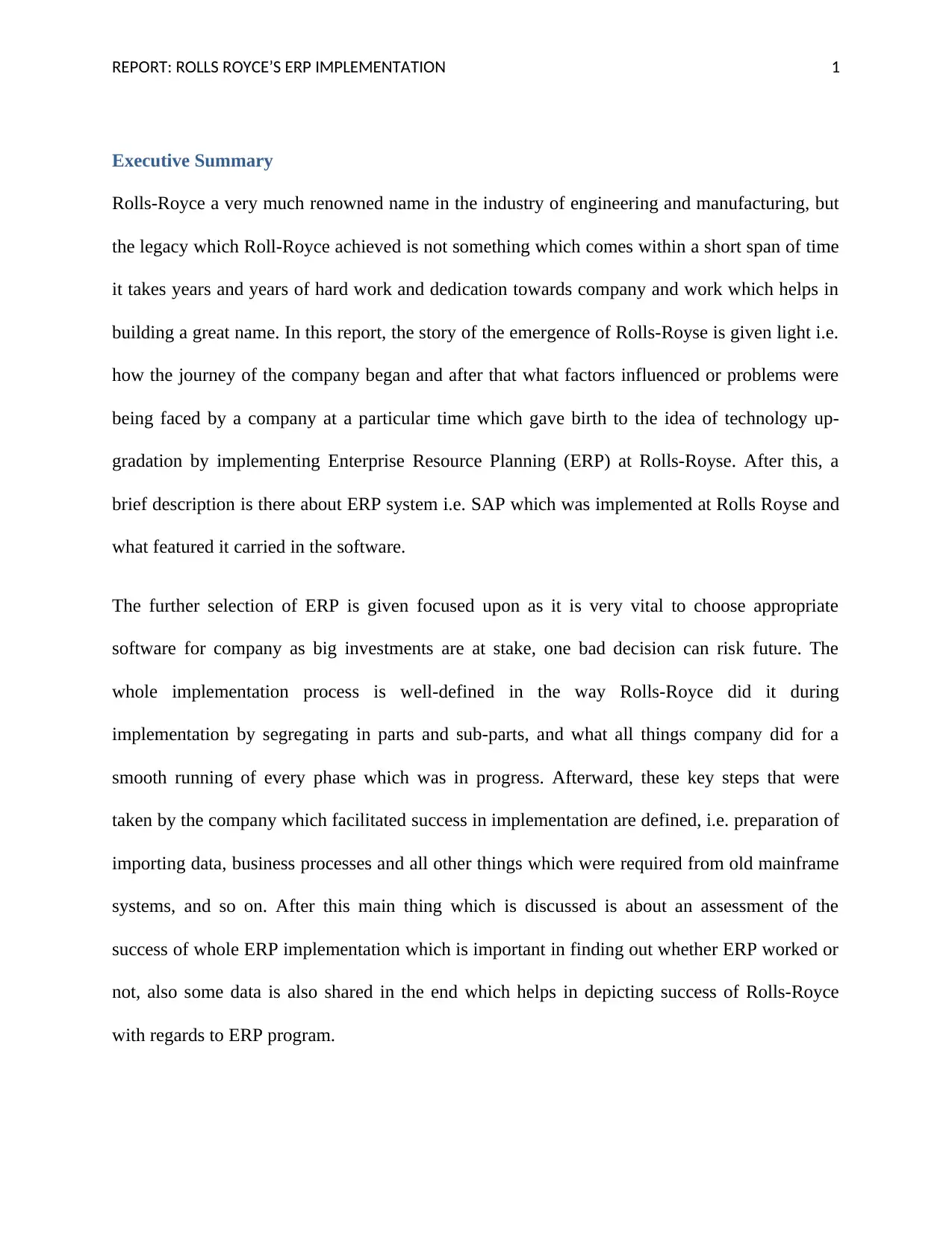
REPORT: ROLLS ROYCE’S ERP IMPLEMENTATION 1
Executive Summary
Rolls-Royce a very much renowned name in the industry of engineering and manufacturing, but
the legacy which Roll-Royce achieved is not something which comes within a short span of time
it takes years and years of hard work and dedication towards company and work which helps in
building a great name. In this report, the story of the emergence of Rolls-Royse is given light i.e.
how the journey of the company began and after that what factors influenced or problems were
being faced by a company at a particular time which gave birth to the idea of technology up-
gradation by implementing Enterprise Resource Planning (ERP) at Rolls-Royse. After this, a
brief description is there about ERP system i.e. SAP which was implemented at Rolls Royse and
what featured it carried in the software.
The further selection of ERP is given focused upon as it is very vital to choose appropriate
software for company as big investments are at stake, one bad decision can risk future. The
whole implementation process is well-defined in the way Rolls-Royce did it during
implementation by segregating in parts and sub-parts, and what all things company did for a
smooth running of every phase which was in progress. Afterward, these key steps that were
taken by the company which facilitated success in implementation are defined, i.e. preparation of
importing data, business processes and all other things which were required from old mainframe
systems, and so on. After this main thing which is discussed is about an assessment of the
success of whole ERP implementation which is important in finding out whether ERP worked or
not, also some data is also shared in the end which helps in depicting success of Rolls-Royce
with regards to ERP program.
Executive Summary
Rolls-Royce a very much renowned name in the industry of engineering and manufacturing, but
the legacy which Roll-Royce achieved is not something which comes within a short span of time
it takes years and years of hard work and dedication towards company and work which helps in
building a great name. In this report, the story of the emergence of Rolls-Royse is given light i.e.
how the journey of the company began and after that what factors influenced or problems were
being faced by a company at a particular time which gave birth to the idea of technology up-
gradation by implementing Enterprise Resource Planning (ERP) at Rolls-Royse. After this, a
brief description is there about ERP system i.e. SAP which was implemented at Rolls Royse and
what featured it carried in the software.
The further selection of ERP is given focused upon as it is very vital to choose appropriate
software for company as big investments are at stake, one bad decision can risk future. The
whole implementation process is well-defined in the way Rolls-Royce did it during
implementation by segregating in parts and sub-parts, and what all things company did for a
smooth running of every phase which was in progress. Afterward, these key steps that were
taken by the company which facilitated success in implementation are defined, i.e. preparation of
importing data, business processes and all other things which were required from old mainframe
systems, and so on. After this main thing which is discussed is about an assessment of the
success of whole ERP implementation which is important in finding out whether ERP worked or
not, also some data is also shared in the end which helps in depicting success of Rolls-Royce
with regards to ERP program.

REPORT: ROLLS ROYCE’S ERP IMPLEMENTATION 2
Table of Contents
Executive Summary.........................................................................................................................1
Introduction......................................................................................................................................3
Rolls-Royce Description..................................................................................................................4
Problems faced.............................................................................................................................5
Rolls-Royce ERP system.................................................................................................................6
Selection of ERP..........................................................................................................................7
Process of implementation...........................................................................................................8
Preparatory steps to facilitate implementation..............................................................................11
Assessment of success...................................................................................................................12
Success Metrics..........................................................................................................................13
Conclusion.....................................................................................................................................14
References......................................................................................................................................15
Table of Contents
Executive Summary.........................................................................................................................1
Introduction......................................................................................................................................3
Rolls-Royce Description..................................................................................................................4
Problems faced.............................................................................................................................5
Rolls-Royce ERP system.................................................................................................................6
Selection of ERP..........................................................................................................................7
Process of implementation...........................................................................................................8
Preparatory steps to facilitate implementation..............................................................................11
Assessment of success...................................................................................................................12
Success Metrics..........................................................................................................................13
Conclusion.....................................................................................................................................14
References......................................................................................................................................15
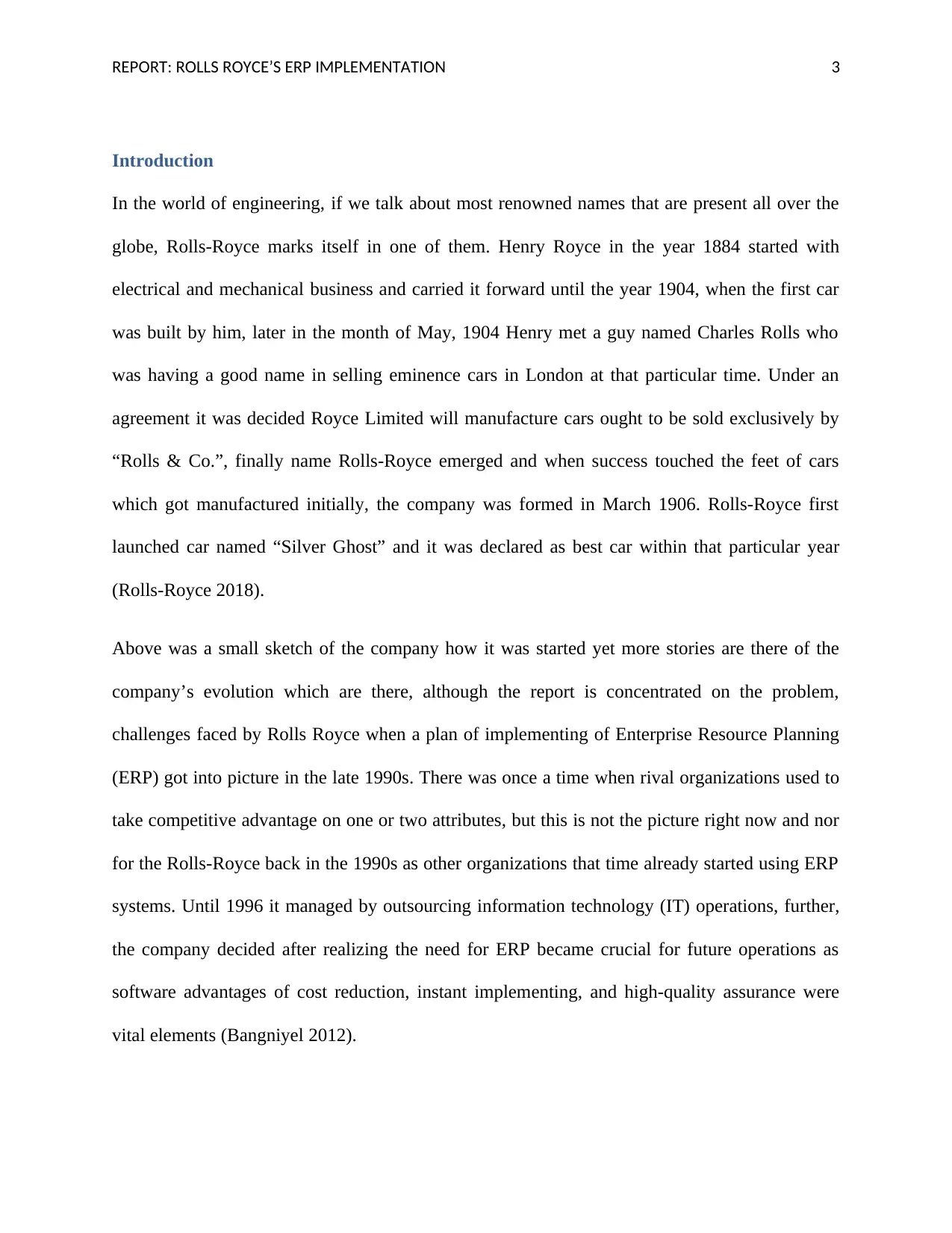
REPORT: ROLLS ROYCE’S ERP IMPLEMENTATION 3
Introduction
In the world of engineering, if we talk about most renowned names that are present all over the
globe, Rolls-Royce marks itself in one of them. Henry Royce in the year 1884 started with
electrical and mechanical business and carried it forward until the year 1904, when the first car
was built by him, later in the month of May, 1904 Henry met a guy named Charles Rolls who
was having a good name in selling eminence cars in London at that particular time. Under an
agreement it was decided Royce Limited will manufacture cars ought to be sold exclusively by
“Rolls & Co.”, finally name Rolls-Royce emerged and when success touched the feet of cars
which got manufactured initially, the company was formed in March 1906. Rolls-Royce first
launched car named “Silver Ghost” and it was declared as best car within that particular year
(Rolls-Royce 2018).
Above was a small sketch of the company how it was started yet more stories are there of the
company’s evolution which are there, although the report is concentrated on the problem,
challenges faced by Rolls Royce when a plan of implementing of Enterprise Resource Planning
(ERP) got into picture in the late 1990s. There was once a time when rival organizations used to
take competitive advantage on one or two attributes, but this is not the picture right now and nor
for the Rolls-Royce back in the 1990s as other organizations that time already started using ERP
systems. Until 1996 it managed by outsourcing information technology (IT) operations, further,
the company decided after realizing the need for ERP became crucial for future operations as
software advantages of cost reduction, instant implementing, and high-quality assurance were
vital elements (Bangniyel 2012).
Introduction
In the world of engineering, if we talk about most renowned names that are present all over the
globe, Rolls-Royce marks itself in one of them. Henry Royce in the year 1884 started with
electrical and mechanical business and carried it forward until the year 1904, when the first car
was built by him, later in the month of May, 1904 Henry met a guy named Charles Rolls who
was having a good name in selling eminence cars in London at that particular time. Under an
agreement it was decided Royce Limited will manufacture cars ought to be sold exclusively by
“Rolls & Co.”, finally name Rolls-Royce emerged and when success touched the feet of cars
which got manufactured initially, the company was formed in March 1906. Rolls-Royce first
launched car named “Silver Ghost” and it was declared as best car within that particular year
(Rolls-Royce 2018).
Above was a small sketch of the company how it was started yet more stories are there of the
company’s evolution which are there, although the report is concentrated on the problem,
challenges faced by Rolls Royce when a plan of implementing of Enterprise Resource Planning
(ERP) got into picture in the late 1990s. There was once a time when rival organizations used to
take competitive advantage on one or two attributes, but this is not the picture right now and nor
for the Rolls-Royce back in the 1990s as other organizations that time already started using ERP
systems. Until 1996 it managed by outsourcing information technology (IT) operations, further,
the company decided after realizing the need for ERP became crucial for future operations as
software advantages of cost reduction, instant implementing, and high-quality assurance were
vital elements (Bangniyel 2012).
Secure Best Marks with AI Grader
Need help grading? Try our AI Grader for instant feedback on your assignments.
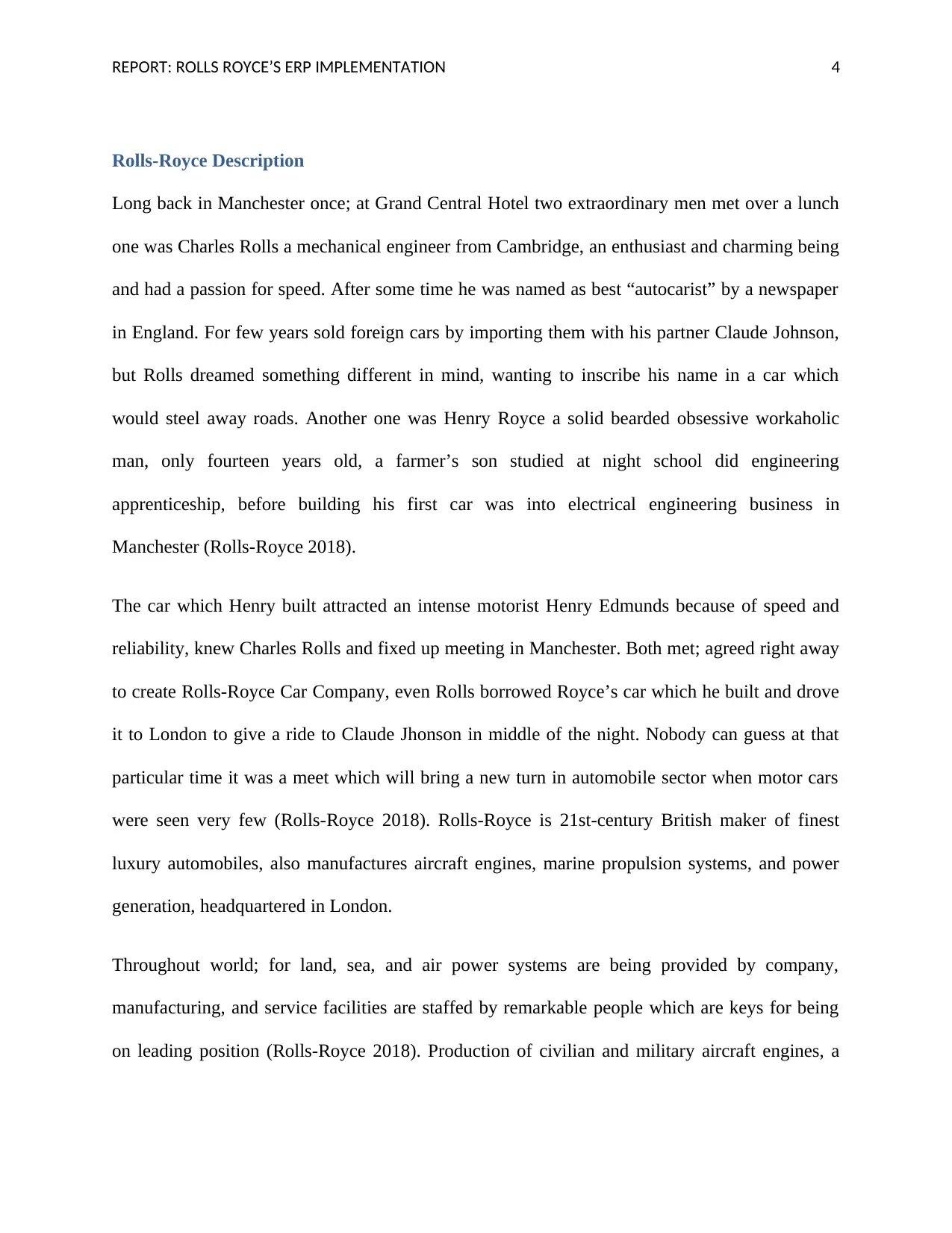
REPORT: ROLLS ROYCE’S ERP IMPLEMENTATION 4
Rolls-Royce Description
Long back in Manchester once; at Grand Central Hotel two extraordinary men met over a lunch
one was Charles Rolls a mechanical engineer from Cambridge, an enthusiast and charming being
and had a passion for speed. After some time he was named as best “autocarist” by a newspaper
in England. For few years sold foreign cars by importing them with his partner Claude Johnson,
but Rolls dreamed something different in mind, wanting to inscribe his name in a car which
would steel away roads. Another one was Henry Royce a solid bearded obsessive workaholic
man, only fourteen years old, a farmer’s son studied at night school did engineering
apprenticeship, before building his first car was into electrical engineering business in
Manchester (Rolls-Royce 2018).
The car which Henry built attracted an intense motorist Henry Edmunds because of speed and
reliability, knew Charles Rolls and fixed up meeting in Manchester. Both met; agreed right away
to create Rolls-Royce Car Company, even Rolls borrowed Royce’s car which he built and drove
it to London to give a ride to Claude Jhonson in middle of the night. Nobody can guess at that
particular time it was a meet which will bring a new turn in automobile sector when motor cars
were seen very few (Rolls-Royce 2018). Rolls-Royce is 21st-century British maker of finest
luxury automobiles, also manufactures aircraft engines, marine propulsion systems, and power
generation, headquartered in London.
Throughout world; for land, sea, and air power systems are being provided by company,
manufacturing, and service facilities are staffed by remarkable people which are keys for being
on leading position (Rolls-Royce 2018). Production of civilian and military aircraft engines, a
Rolls-Royce Description
Long back in Manchester once; at Grand Central Hotel two extraordinary men met over a lunch
one was Charles Rolls a mechanical engineer from Cambridge, an enthusiast and charming being
and had a passion for speed. After some time he was named as best “autocarist” by a newspaper
in England. For few years sold foreign cars by importing them with his partner Claude Johnson,
but Rolls dreamed something different in mind, wanting to inscribe his name in a car which
would steel away roads. Another one was Henry Royce a solid bearded obsessive workaholic
man, only fourteen years old, a farmer’s son studied at night school did engineering
apprenticeship, before building his first car was into electrical engineering business in
Manchester (Rolls-Royce 2018).
The car which Henry built attracted an intense motorist Henry Edmunds because of speed and
reliability, knew Charles Rolls and fixed up meeting in Manchester. Both met; agreed right away
to create Rolls-Royce Car Company, even Rolls borrowed Royce’s car which he built and drove
it to London to give a ride to Claude Jhonson in middle of the night. Nobody can guess at that
particular time it was a meet which will bring a new turn in automobile sector when motor cars
were seen very few (Rolls-Royce 2018). Rolls-Royce is 21st-century British maker of finest
luxury automobiles, also manufactures aircraft engines, marine propulsion systems, and power
generation, headquartered in London.
Throughout world; for land, sea, and air power systems are being provided by company,
manufacturing, and service facilities are staffed by remarkable people which are keys for being
on leading position (Rolls-Royce 2018). Production of civilian and military aircraft engines, a
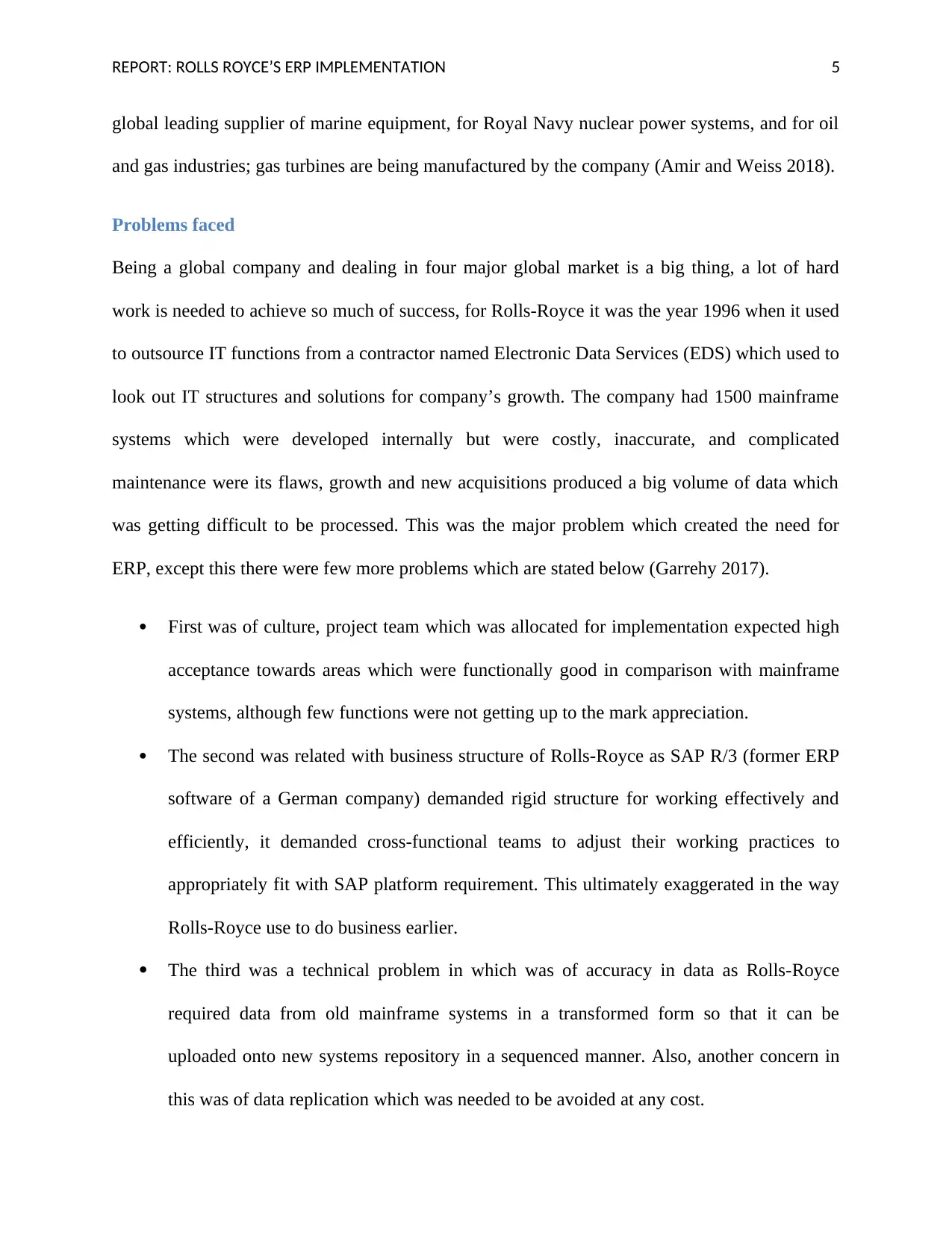
REPORT: ROLLS ROYCE’S ERP IMPLEMENTATION 5
global leading supplier of marine equipment, for Royal Navy nuclear power systems, and for oil
and gas industries; gas turbines are being manufactured by the company (Amir and Weiss 2018).
Problems faced
Being a global company and dealing in four major global market is a big thing, a lot of hard
work is needed to achieve so much of success, for Rolls-Royce it was the year 1996 when it used
to outsource IT functions from a contractor named Electronic Data Services (EDS) which used to
look out IT structures and solutions for company’s growth. The company had 1500 mainframe
systems which were developed internally but were costly, inaccurate, and complicated
maintenance were its flaws, growth and new acquisitions produced a big volume of data which
was getting difficult to be processed. This was the major problem which created the need for
ERP, except this there were few more problems which are stated below (Garrehy 2017).
First was of culture, project team which was allocated for implementation expected high
acceptance towards areas which were functionally good in comparison with mainframe
systems, although few functions were not getting up to the mark appreciation.
The second was related with business structure of Rolls-Royce as SAP R/3 (former ERP
software of a German company) demanded rigid structure for working effectively and
efficiently, it demanded cross-functional teams to adjust their working practices to
appropriately fit with SAP platform requirement. This ultimately exaggerated in the way
Rolls-Royce use to do business earlier.
The third was a technical problem in which was of accuracy in data as Rolls-Royce
required data from old mainframe systems in a transformed form so that it can be
uploaded onto new systems repository in a sequenced manner. Also, another concern in
this was of data replication which was needed to be avoided at any cost.
global leading supplier of marine equipment, for Royal Navy nuclear power systems, and for oil
and gas industries; gas turbines are being manufactured by the company (Amir and Weiss 2018).
Problems faced
Being a global company and dealing in four major global market is a big thing, a lot of hard
work is needed to achieve so much of success, for Rolls-Royce it was the year 1996 when it used
to outsource IT functions from a contractor named Electronic Data Services (EDS) which used to
look out IT structures and solutions for company’s growth. The company had 1500 mainframe
systems which were developed internally but were costly, inaccurate, and complicated
maintenance were its flaws, growth and new acquisitions produced a big volume of data which
was getting difficult to be processed. This was the major problem which created the need for
ERP, except this there were few more problems which are stated below (Garrehy 2017).
First was of culture, project team which was allocated for implementation expected high
acceptance towards areas which were functionally good in comparison with mainframe
systems, although few functions were not getting up to the mark appreciation.
The second was related with business structure of Rolls-Royce as SAP R/3 (former ERP
software of a German company) demanded rigid structure for working effectively and
efficiently, it demanded cross-functional teams to adjust their working practices to
appropriately fit with SAP platform requirement. This ultimately exaggerated in the way
Rolls-Royce use to do business earlier.
The third was a technical problem in which was of accuracy in data as Rolls-Royce
required data from old mainframe systems in a transformed form so that it can be
uploaded onto new systems repository in a sequenced manner. Also, another concern in
this was of data replication which was needed to be avoided at any cost.
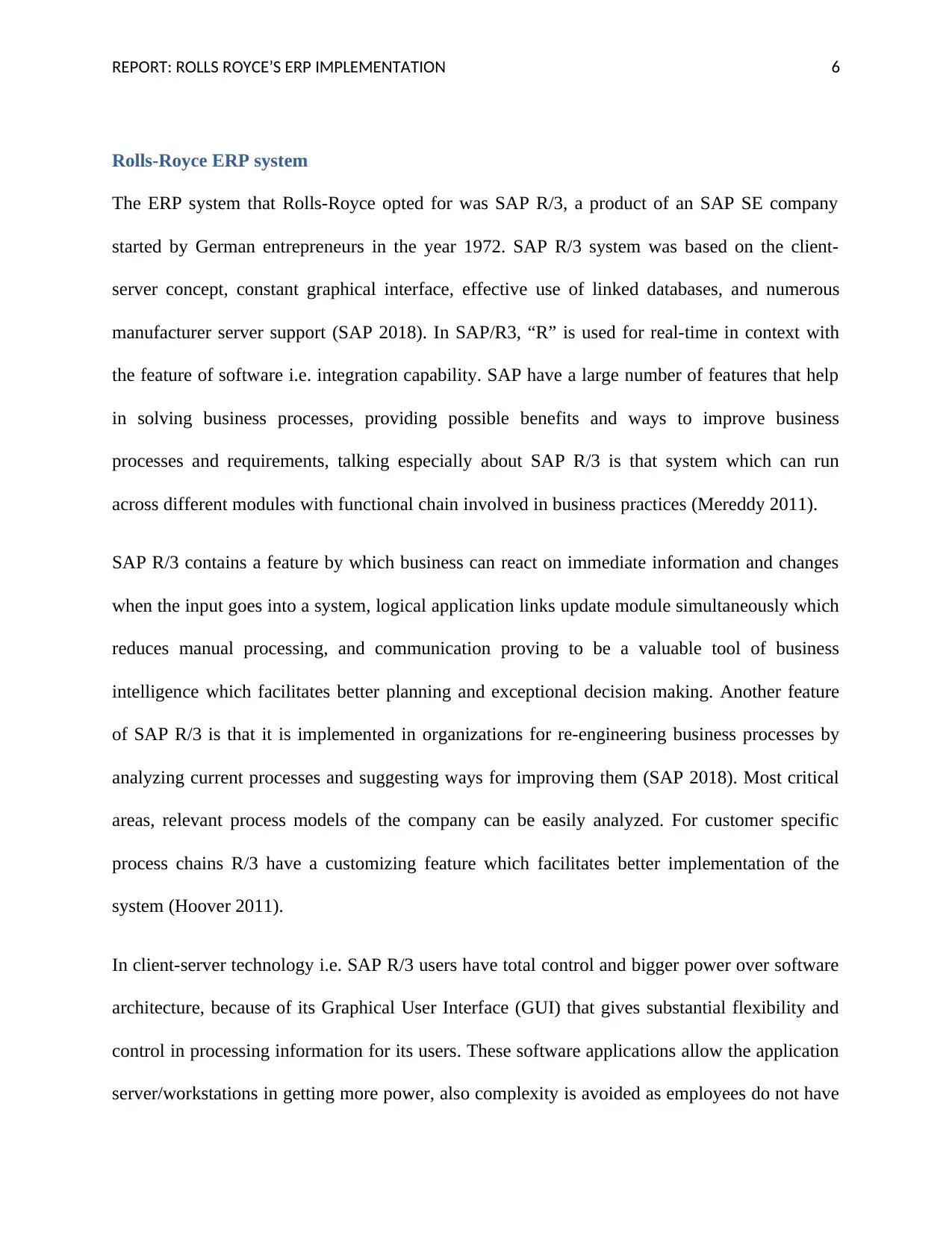
REPORT: ROLLS ROYCE’S ERP IMPLEMENTATION 6
Rolls-Royce ERP system
The ERP system that Rolls-Royce opted for was SAP R/3, a product of an SAP SE company
started by German entrepreneurs in the year 1972. SAP R/3 system was based on the client-
server concept, constant graphical interface, effective use of linked databases, and numerous
manufacturer server support (SAP 2018). In SAP/R3, “R” is used for real-time in context with
the feature of software i.e. integration capability. SAP have a large number of features that help
in solving business processes, providing possible benefits and ways to improve business
processes and requirements, talking especially about SAP R/3 is that system which can run
across different modules with functional chain involved in business practices (Mereddy 2011).
SAP R/3 contains a feature by which business can react on immediate information and changes
when the input goes into a system, logical application links update module simultaneously which
reduces manual processing, and communication proving to be a valuable tool of business
intelligence which facilitates better planning and exceptional decision making. Another feature
of SAP R/3 is that it is implemented in organizations for re-engineering business processes by
analyzing current processes and suggesting ways for improving them (SAP 2018). Most critical
areas, relevant process models of the company can be easily analyzed. For customer specific
process chains R/3 have a customizing feature which facilitates better implementation of the
system (Hoover 2011).
In client-server technology i.e. SAP R/3 users have total control and bigger power over software
architecture, because of its Graphical User Interface (GUI) that gives substantial flexibility and
control in processing information for its users. These software applications allow the application
server/workstations in getting more power, also complexity is avoided as employees do not have
Rolls-Royce ERP system
The ERP system that Rolls-Royce opted for was SAP R/3, a product of an SAP SE company
started by German entrepreneurs in the year 1972. SAP R/3 system was based on the client-
server concept, constant graphical interface, effective use of linked databases, and numerous
manufacturer server support (SAP 2018). In SAP/R3, “R” is used for real-time in context with
the feature of software i.e. integration capability. SAP have a large number of features that help
in solving business processes, providing possible benefits and ways to improve business
processes and requirements, talking especially about SAP R/3 is that system which can run
across different modules with functional chain involved in business practices (Mereddy 2011).
SAP R/3 contains a feature by which business can react on immediate information and changes
when the input goes into a system, logical application links update module simultaneously which
reduces manual processing, and communication proving to be a valuable tool of business
intelligence which facilitates better planning and exceptional decision making. Another feature
of SAP R/3 is that it is implemented in organizations for re-engineering business processes by
analyzing current processes and suggesting ways for improving them (SAP 2018). Most critical
areas, relevant process models of the company can be easily analyzed. For customer specific
process chains R/3 have a customizing feature which facilitates better implementation of the
system (Hoover 2011).
In client-server technology i.e. SAP R/3 users have total control and bigger power over software
architecture, because of its Graphical User Interface (GUI) that gives substantial flexibility and
control in processing information for its users. These software applications allow the application
server/workstations in getting more power, also complexity is avoided as employees do not have
Paraphrase This Document
Need a fresh take? Get an instant paraphrase of this document with our AI Paraphraser
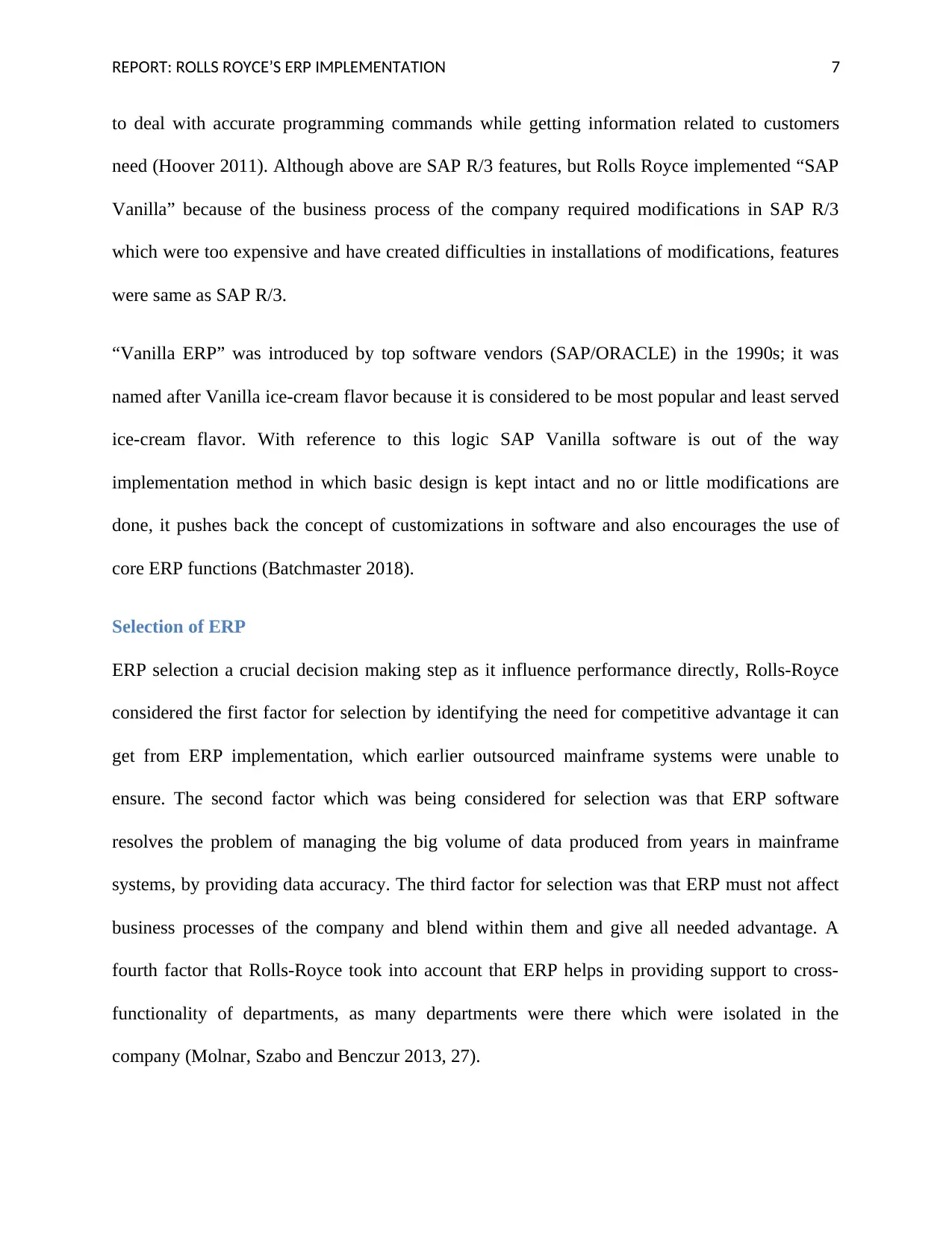
REPORT: ROLLS ROYCE’S ERP IMPLEMENTATION 7
to deal with accurate programming commands while getting information related to customers
need (Hoover 2011). Although above are SAP R/3 features, but Rolls Royce implemented “SAP
Vanilla” because of the business process of the company required modifications in SAP R/3
which were too expensive and have created difficulties in installations of modifications, features
were same as SAP R/3.
“Vanilla ERP” was introduced by top software vendors (SAP/ORACLE) in the 1990s; it was
named after Vanilla ice-cream flavor because it is considered to be most popular and least served
ice-cream flavor. With reference to this logic SAP Vanilla software is out of the way
implementation method in which basic design is kept intact and no or little modifications are
done, it pushes back the concept of customizations in software and also encourages the use of
core ERP functions (Batchmaster 2018).
Selection of ERP
ERP selection a crucial decision making step as it influence performance directly, Rolls-Royce
considered the first factor for selection by identifying the need for competitive advantage it can
get from ERP implementation, which earlier outsourced mainframe systems were unable to
ensure. The second factor which was being considered for selection was that ERP software
resolves the problem of managing the big volume of data produced from years in mainframe
systems, by providing data accuracy. The third factor for selection was that ERP must not affect
business processes of the company and blend within them and give all needed advantage. A
fourth factor that Rolls-Royce took into account that ERP helps in providing support to cross-
functionality of departments, as many departments were there which were isolated in the
company (Molnar, Szabo and Benczur 2013, 27).
to deal with accurate programming commands while getting information related to customers
need (Hoover 2011). Although above are SAP R/3 features, but Rolls Royce implemented “SAP
Vanilla” because of the business process of the company required modifications in SAP R/3
which were too expensive and have created difficulties in installations of modifications, features
were same as SAP R/3.
“Vanilla ERP” was introduced by top software vendors (SAP/ORACLE) in the 1990s; it was
named after Vanilla ice-cream flavor because it is considered to be most popular and least served
ice-cream flavor. With reference to this logic SAP Vanilla software is out of the way
implementation method in which basic design is kept intact and no or little modifications are
done, it pushes back the concept of customizations in software and also encourages the use of
core ERP functions (Batchmaster 2018).
Selection of ERP
ERP selection a crucial decision making step as it influence performance directly, Rolls-Royce
considered the first factor for selection by identifying the need for competitive advantage it can
get from ERP implementation, which earlier outsourced mainframe systems were unable to
ensure. The second factor which was being considered for selection was that ERP software
resolves the problem of managing the big volume of data produced from years in mainframe
systems, by providing data accuracy. The third factor for selection was that ERP must not affect
business processes of the company and blend within them and give all needed advantage. A
fourth factor that Rolls-Royce took into account that ERP helps in providing support to cross-
functionality of departments, as many departments were there which were isolated in the
company (Molnar, Szabo and Benczur 2013, 27).
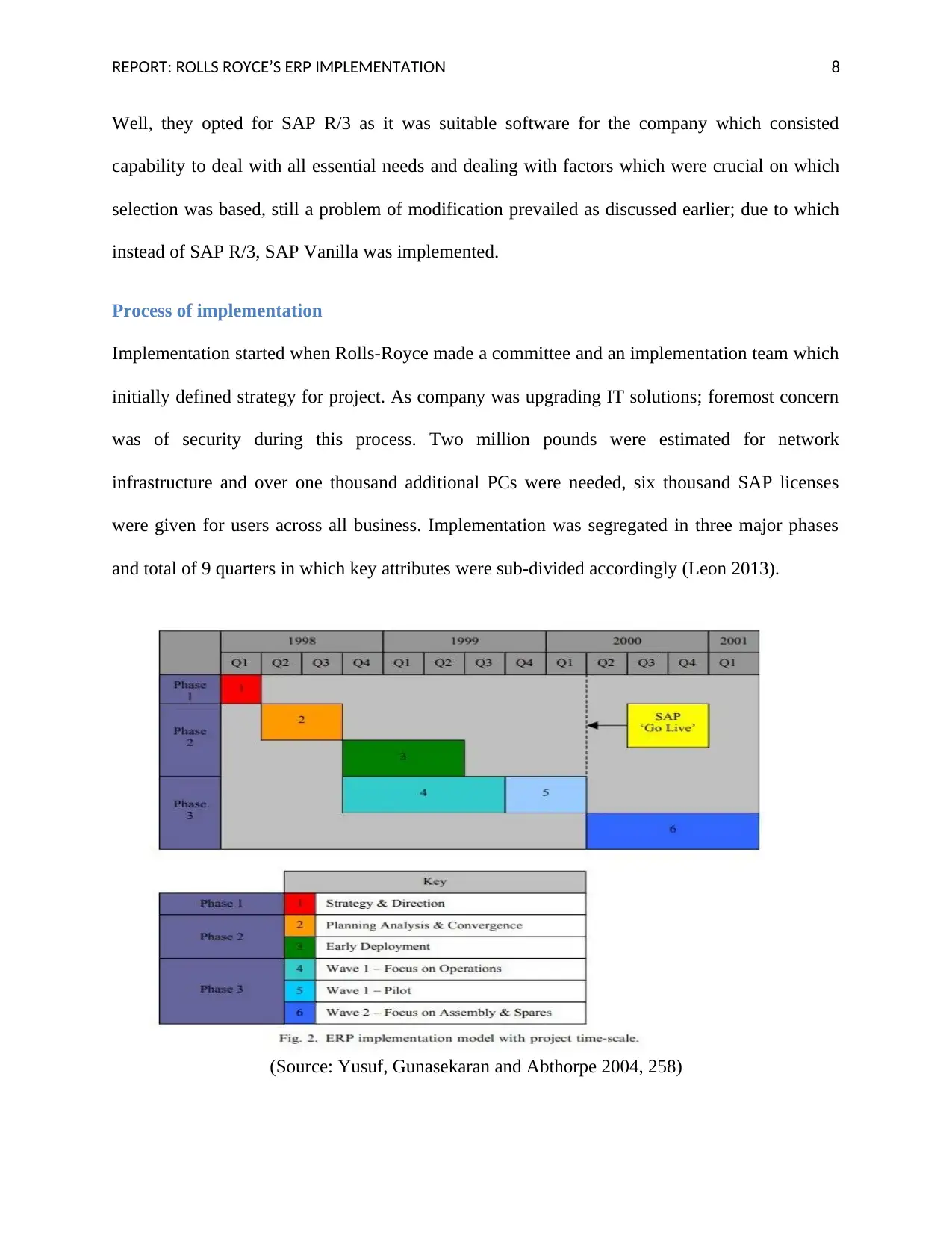
REPORT: ROLLS ROYCE’S ERP IMPLEMENTATION 8
Well, they opted for SAP R/3 as it was suitable software for the company which consisted
capability to deal with all essential needs and dealing with factors which were crucial on which
selection was based, still a problem of modification prevailed as discussed earlier; due to which
instead of SAP R/3, SAP Vanilla was implemented.
Process of implementation
Implementation started when Rolls-Royce made a committee and an implementation team which
initially defined strategy for project. As company was upgrading IT solutions; foremost concern
was of security during this process. Two million pounds were estimated for network
infrastructure and over one thousand additional PCs were needed, six thousand SAP licenses
were given for users across all business. Implementation was segregated in three major phases
and total of 9 quarters in which key attributes were sub-divided accordingly (Leon 2013).
(Source: Yusuf, Gunasekaran and Abthorpe 2004, 258)
Well, they opted for SAP R/3 as it was suitable software for the company which consisted
capability to deal with all essential needs and dealing with factors which were crucial on which
selection was based, still a problem of modification prevailed as discussed earlier; due to which
instead of SAP R/3, SAP Vanilla was implemented.
Process of implementation
Implementation started when Rolls-Royce made a committee and an implementation team which
initially defined strategy for project. As company was upgrading IT solutions; foremost concern
was of security during this process. Two million pounds were estimated for network
infrastructure and over one thousand additional PCs were needed, six thousand SAP licenses
were given for users across all business. Implementation was segregated in three major phases
and total of 9 quarters in which key attributes were sub-divided accordingly (Leon 2013).
(Source: Yusuf, Gunasekaran and Abthorpe 2004, 258)
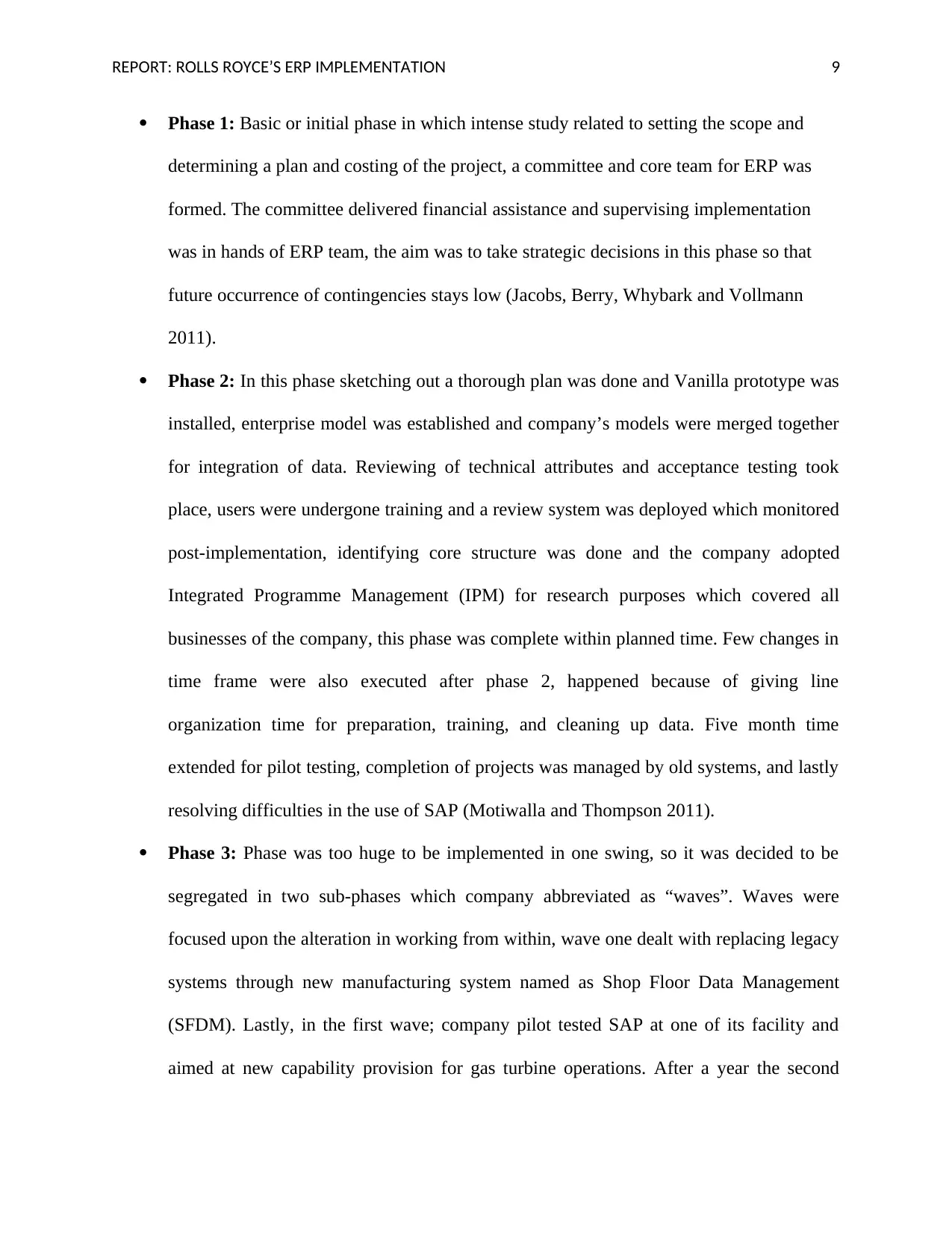
REPORT: ROLLS ROYCE’S ERP IMPLEMENTATION 9
Phase 1: Basic or initial phase in which intense study related to setting the scope and
determining a plan and costing of the project, a committee and core team for ERP was
formed. The committee delivered financial assistance and supervising implementation
was in hands of ERP team, the aim was to take strategic decisions in this phase so that
future occurrence of contingencies stays low (Jacobs, Berry, Whybark and Vollmann
2011).
Phase 2: In this phase sketching out a thorough plan was done and Vanilla prototype was
installed, enterprise model was established and company’s models were merged together
for integration of data. Reviewing of technical attributes and acceptance testing took
place, users were undergone training and a review system was deployed which monitored
post-implementation, identifying core structure was done and the company adopted
Integrated Programme Management (IPM) for research purposes which covered all
businesses of the company, this phase was complete within planned time. Few changes in
time frame were also executed after phase 2, happened because of giving line
organization time for preparation, training, and cleaning up data. Five month time
extended for pilot testing, completion of projects was managed by old systems, and lastly
resolving difficulties in the use of SAP (Motiwalla and Thompson 2011).
Phase 3: Phase was too huge to be implemented in one swing, so it was decided to be
segregated in two sub-phases which company abbreviated as “waves”. Waves were
focused upon the alteration in working from within, wave one dealt with replacing legacy
systems through new manufacturing system named as Shop Floor Data Management
(SFDM). Lastly, in the first wave; company pilot tested SAP at one of its facility and
aimed at new capability provision for gas turbine operations. After a year the second
Phase 1: Basic or initial phase in which intense study related to setting the scope and
determining a plan and costing of the project, a committee and core team for ERP was
formed. The committee delivered financial assistance and supervising implementation
was in hands of ERP team, the aim was to take strategic decisions in this phase so that
future occurrence of contingencies stays low (Jacobs, Berry, Whybark and Vollmann
2011).
Phase 2: In this phase sketching out a thorough plan was done and Vanilla prototype was
installed, enterprise model was established and company’s models were merged together
for integration of data. Reviewing of technical attributes and acceptance testing took
place, users were undergone training and a review system was deployed which monitored
post-implementation, identifying core structure was done and the company adopted
Integrated Programme Management (IPM) for research purposes which covered all
businesses of the company, this phase was complete within planned time. Few changes in
time frame were also executed after phase 2, happened because of giving line
organization time for preparation, training, and cleaning up data. Five month time
extended for pilot testing, completion of projects was managed by old systems, and lastly
resolving difficulties in the use of SAP (Motiwalla and Thompson 2011).
Phase 3: Phase was too huge to be implemented in one swing, so it was decided to be
segregated in two sub-phases which company abbreviated as “waves”. Waves were
focused upon the alteration in working from within, wave one dealt with replacing legacy
systems through new manufacturing system named as Shop Floor Data Management
(SFDM). Lastly, in the first wave; company pilot tested SAP at one of its facility and
aimed at new capability provision for gas turbine operations. After a year the second
Secure Best Marks with AI Grader
Need help grading? Try our AI Grader for instant feedback on your assignments.
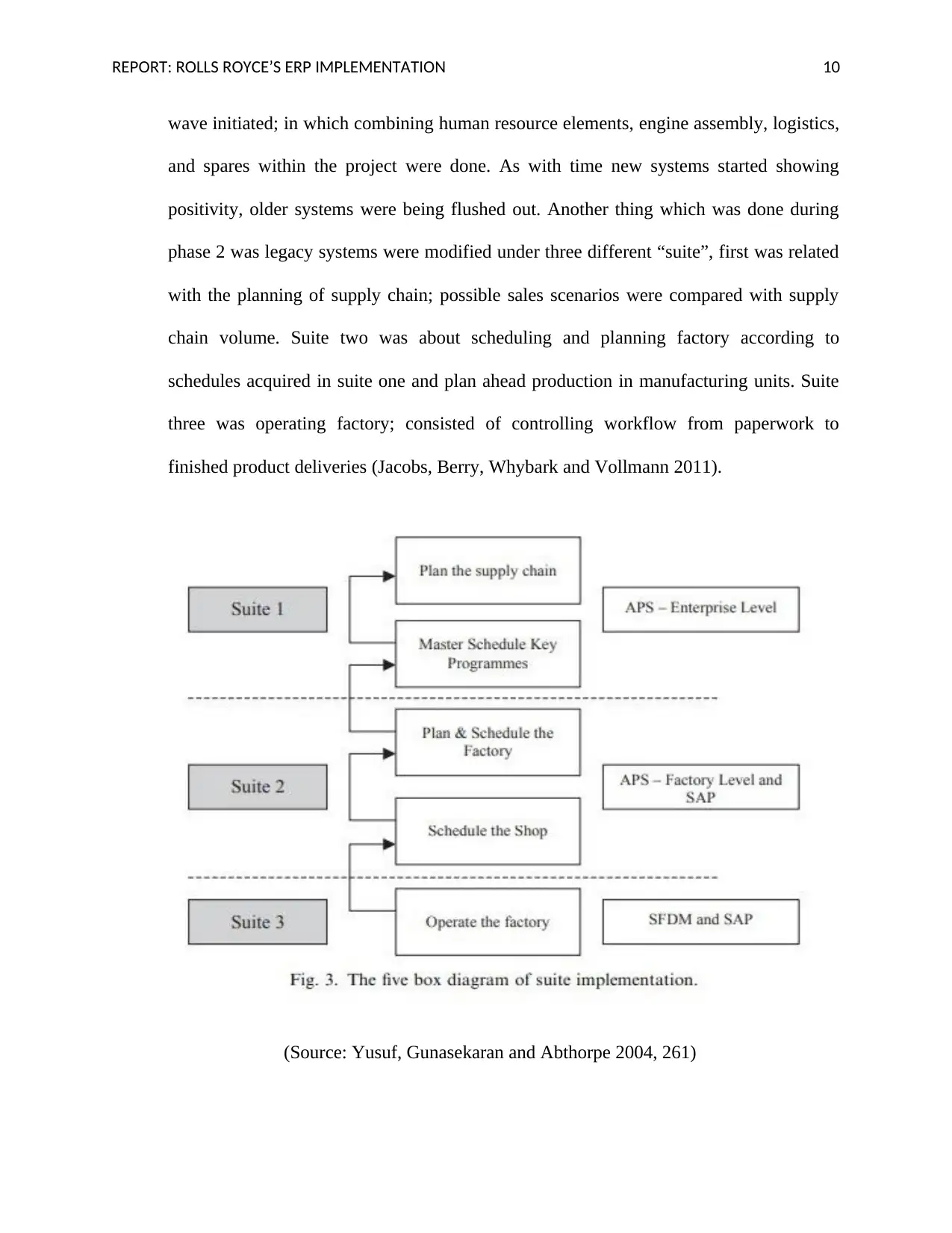
REPORT: ROLLS ROYCE’S ERP IMPLEMENTATION 10
wave initiated; in which combining human resource elements, engine assembly, logistics,
and spares within the project were done. As with time new systems started showing
positivity, older systems were being flushed out. Another thing which was done during
phase 2 was legacy systems were modified under three different “suite”, first was related
with the planning of supply chain; possible sales scenarios were compared with supply
chain volume. Suite two was about scheduling and planning factory according to
schedules acquired in suite one and plan ahead production in manufacturing units. Suite
three was operating factory; consisted of controlling workflow from paperwork to
finished product deliveries (Jacobs, Berry, Whybark and Vollmann 2011).
(Source: Yusuf, Gunasekaran and Abthorpe 2004, 261)
wave initiated; in which combining human resource elements, engine assembly, logistics,
and spares within the project were done. As with time new systems started showing
positivity, older systems were being flushed out. Another thing which was done during
phase 2 was legacy systems were modified under three different “suite”, first was related
with the planning of supply chain; possible sales scenarios were compared with supply
chain volume. Suite two was about scheduling and planning factory according to
schedules acquired in suite one and plan ahead production in manufacturing units. Suite
three was operating factory; consisted of controlling workflow from paperwork to
finished product deliveries (Jacobs, Berry, Whybark and Vollmann 2011).
(Source: Yusuf, Gunasekaran and Abthorpe 2004, 261)

REPORT: ROLLS ROYCE’S ERP IMPLEMENTATION 11
Preparatory steps to facilitate implementation
Few steps were followed by Rolls-Royce which helped the company in facilitating implementing
SAP quite brilliantly, firstly Rolls-Royce prepared well for importing data, business processes,
modules, and every other related information from legacy systems to new system one by one
without rushing through. Second; Rolls-Royce created an ERP team and committee in the initial
phase to look at the planned implementation. The third step which company took was of keeping
customization minimum because it extends the time of implementation, this helped SAP Vanilla
to appropriately merge within business processes (Miller 2018).
The fourth step which Rolls-Royce adhered was the execution of pilot testing system at one of
their facility which was vital when they actually ran the whole system for the very first. The fifth
step was implementation team on every phase involved every personnel of company so they can
infuse new system and processes to work accordingly, the team extended time frame due to
employees training and other stuff. Sixth was of accepting ERP system without resisting towards
change, this is vital because if Rolls-Royce would have feared of anything like, how so much
data would be transferred, how long implementation would be, loss of data, and all these things,
then it would not have been successful at all. So these are few of preparatory steps that Rolls-
Royce took so that implementation of ERP can be assisted successfully (Miller 2018).
Preparatory steps to facilitate implementation
Few steps were followed by Rolls-Royce which helped the company in facilitating implementing
SAP quite brilliantly, firstly Rolls-Royce prepared well for importing data, business processes,
modules, and every other related information from legacy systems to new system one by one
without rushing through. Second; Rolls-Royce created an ERP team and committee in the initial
phase to look at the planned implementation. The third step which company took was of keeping
customization minimum because it extends the time of implementation, this helped SAP Vanilla
to appropriately merge within business processes (Miller 2018).
The fourth step which Rolls-Royce adhered was the execution of pilot testing system at one of
their facility which was vital when they actually ran the whole system for the very first. The fifth
step was implementation team on every phase involved every personnel of company so they can
infuse new system and processes to work accordingly, the team extended time frame due to
employees training and other stuff. Sixth was of accepting ERP system without resisting towards
change, this is vital because if Rolls-Royce would have feared of anything like, how so much
data would be transferred, how long implementation would be, loss of data, and all these things,
then it would not have been successful at all. So these are few of preparatory steps that Rolls-
Royce took so that implementation of ERP can be assisted successfully (Miller 2018).
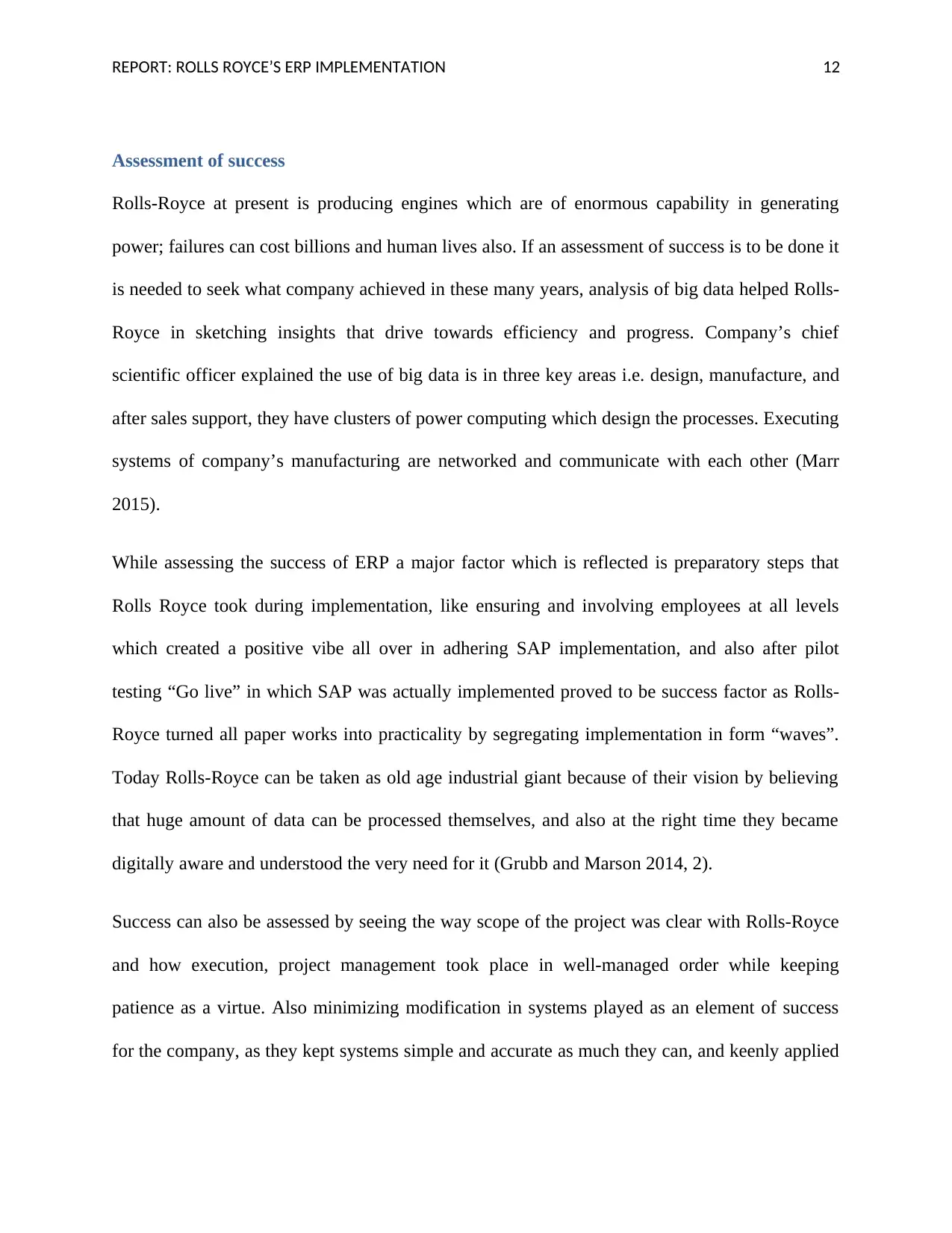
REPORT: ROLLS ROYCE’S ERP IMPLEMENTATION 12
Assessment of success
Rolls-Royce at present is producing engines which are of enormous capability in generating
power; failures can cost billions and human lives also. If an assessment of success is to be done it
is needed to seek what company achieved in these many years, analysis of big data helped Rolls-
Royce in sketching insights that drive towards efficiency and progress. Company’s chief
scientific officer explained the use of big data is in three key areas i.e. design, manufacture, and
after sales support, they have clusters of power computing which design the processes. Executing
systems of company’s manufacturing are networked and communicate with each other (Marr
2015).
While assessing the success of ERP a major factor which is reflected is preparatory steps that
Rolls Royce took during implementation, like ensuring and involving employees at all levels
which created a positive vibe all over in adhering SAP implementation, and also after pilot
testing “Go live” in which SAP was actually implemented proved to be success factor as Rolls-
Royce turned all paper works into practicality by segregating implementation in form “waves”.
Today Rolls-Royce can be taken as old age industrial giant because of their vision by believing
that huge amount of data can be processed themselves, and also at the right time they became
digitally aware and understood the very need for it (Grubb and Marson 2014, 2).
Success can also be assessed by seeing the way scope of the project was clear with Rolls-Royce
and how execution, project management took place in well-managed order while keeping
patience as a virtue. Also minimizing modification in systems played as an element of success
for the company, as they kept systems simple and accurate as much they can, and keenly applied
Assessment of success
Rolls-Royce at present is producing engines which are of enormous capability in generating
power; failures can cost billions and human lives also. If an assessment of success is to be done it
is needed to seek what company achieved in these many years, analysis of big data helped Rolls-
Royce in sketching insights that drive towards efficiency and progress. Company’s chief
scientific officer explained the use of big data is in three key areas i.e. design, manufacture, and
after sales support, they have clusters of power computing which design the processes. Executing
systems of company’s manufacturing are networked and communicate with each other (Marr
2015).
While assessing the success of ERP a major factor which is reflected is preparatory steps that
Rolls Royce took during implementation, like ensuring and involving employees at all levels
which created a positive vibe all over in adhering SAP implementation, and also after pilot
testing “Go live” in which SAP was actually implemented proved to be success factor as Rolls-
Royce turned all paper works into practicality by segregating implementation in form “waves”.
Today Rolls-Royce can be taken as old age industrial giant because of their vision by believing
that huge amount of data can be processed themselves, and also at the right time they became
digitally aware and understood the very need for it (Grubb and Marson 2014, 2).
Success can also be assessed by seeing the way scope of the project was clear with Rolls-Royce
and how execution, project management took place in well-managed order while keeping
patience as a virtue. Also minimizing modification in systems played as an element of success
for the company, as they kept systems simple and accurate as much they can, and keenly applied
Paraphrase This Document
Need a fresh take? Get an instant paraphrase of this document with our AI Paraphraser

REPORT: ROLLS ROYCE’S ERP IMPLEMENTATION 13
knowledge related with business process at every stage of the implementation process. So these
are all arguments which depict or assess ERP success at Rolls-Royce (Lammers 2014).
Success Metrics
Although any metrics related at the time of implementation is not possible to get the hands-on;
still annual report of the year 2001 can give a glimpse, as in the year 2000 implementation was
completed after the first quarter. Few analyses can be seen in below images:
(Rolls-Royce Annual Report 2001)
Above are data from the annual report of Rolls-Royce from the year 2001, in which we can see
an increase in the sale of civil aerospace, marine sales, and energy sales that how gradually they
are increasing year by year consequently. If the focus is given then it can be seen that years
during ERP implementation stage/phase were also increasing sales gradually. If a view is given
knowledge related with business process at every stage of the implementation process. So these
are all arguments which depict or assess ERP success at Rolls-Royce (Lammers 2014).
Success Metrics
Although any metrics related at the time of implementation is not possible to get the hands-on;
still annual report of the year 2001 can give a glimpse, as in the year 2000 implementation was
completed after the first quarter. Few analyses can be seen in below images:
(Rolls-Royce Annual Report 2001)
Above are data from the annual report of Rolls-Royce from the year 2001, in which we can see
an increase in the sale of civil aerospace, marine sales, and energy sales that how gradually they
are increasing year by year consequently. If the focus is given then it can be seen that years
during ERP implementation stage/phase were also increasing sales gradually. If a view is given
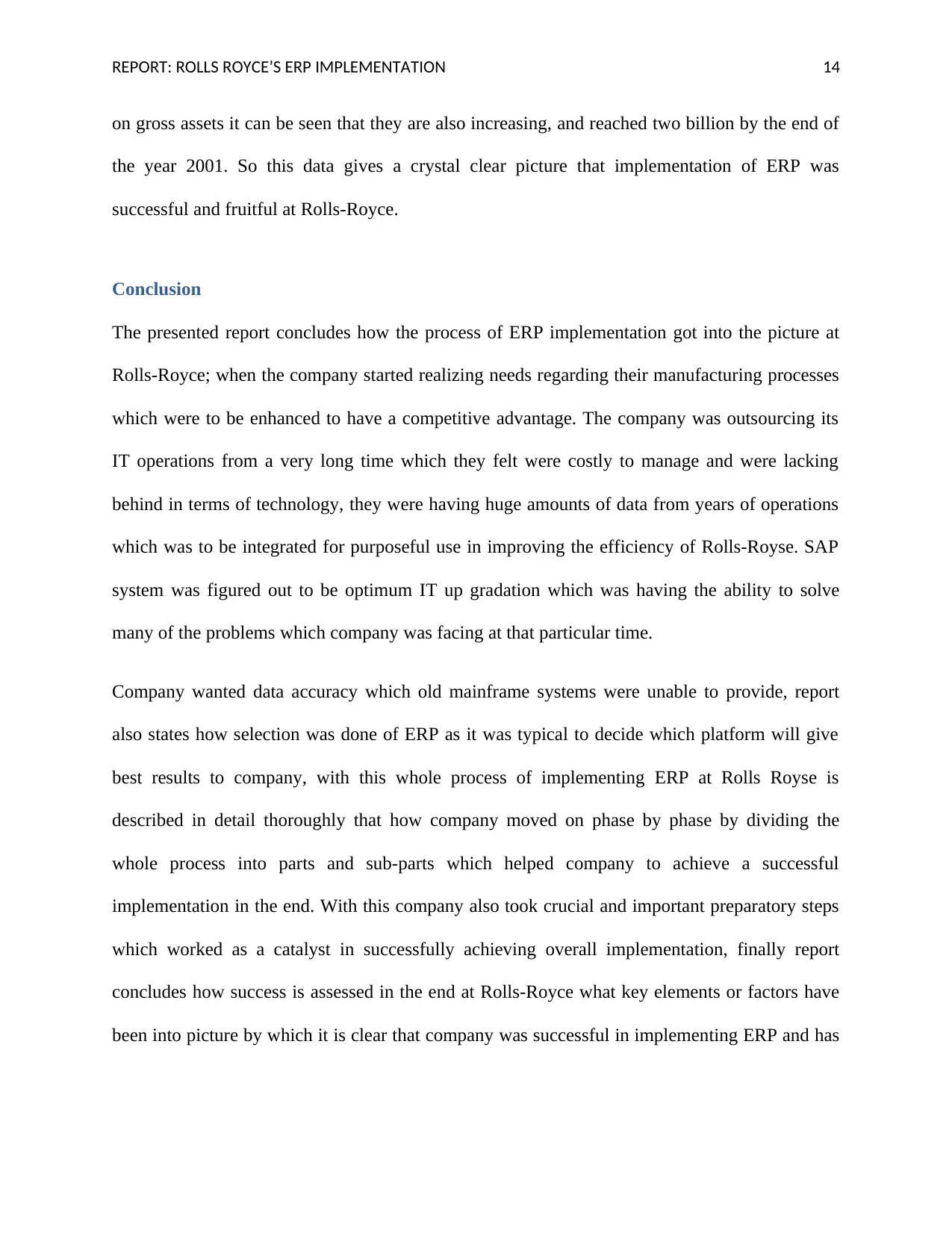
REPORT: ROLLS ROYCE’S ERP IMPLEMENTATION 14
on gross assets it can be seen that they are also increasing, and reached two billion by the end of
the year 2001. So this data gives a crystal clear picture that implementation of ERP was
successful and fruitful at Rolls-Royce.
Conclusion
The presented report concludes how the process of ERP implementation got into the picture at
Rolls-Royce; when the company started realizing needs regarding their manufacturing processes
which were to be enhanced to have a competitive advantage. The company was outsourcing its
IT operations from a very long time which they felt were costly to manage and were lacking
behind in terms of technology, they were having huge amounts of data from years of operations
which was to be integrated for purposeful use in improving the efficiency of Rolls-Royse. SAP
system was figured out to be optimum IT up gradation which was having the ability to solve
many of the problems which company was facing at that particular time.
Company wanted data accuracy which old mainframe systems were unable to provide, report
also states how selection was done of ERP as it was typical to decide which platform will give
best results to company, with this whole process of implementing ERP at Rolls Royse is
described in detail thoroughly that how company moved on phase by phase by dividing the
whole process into parts and sub-parts which helped company to achieve a successful
implementation in the end. With this company also took crucial and important preparatory steps
which worked as a catalyst in successfully achieving overall implementation, finally report
concludes how success is assessed in the end at Rolls-Royce what key elements or factors have
been into picture by which it is clear that company was successful in implementing ERP and has
on gross assets it can be seen that they are also increasing, and reached two billion by the end of
the year 2001. So this data gives a crystal clear picture that implementation of ERP was
successful and fruitful at Rolls-Royce.
Conclusion
The presented report concludes how the process of ERP implementation got into the picture at
Rolls-Royce; when the company started realizing needs regarding their manufacturing processes
which were to be enhanced to have a competitive advantage. The company was outsourcing its
IT operations from a very long time which they felt were costly to manage and were lacking
behind in terms of technology, they were having huge amounts of data from years of operations
which was to be integrated for purposeful use in improving the efficiency of Rolls-Royse. SAP
system was figured out to be optimum IT up gradation which was having the ability to solve
many of the problems which company was facing at that particular time.
Company wanted data accuracy which old mainframe systems were unable to provide, report
also states how selection was done of ERP as it was typical to decide which platform will give
best results to company, with this whole process of implementing ERP at Rolls Royse is
described in detail thoroughly that how company moved on phase by phase by dividing the
whole process into parts and sub-parts which helped company to achieve a successful
implementation in the end. With this company also took crucial and important preparatory steps
which worked as a catalyst in successfully achieving overall implementation, finally report
concludes how success is assessed in the end at Rolls-Royce what key elements or factors have
been into picture by which it is clear that company was successful in implementing ERP and has

REPORT: ROLLS ROYCE’S ERP IMPLEMENTATION 15
brought expected and desired results. Also, some data, in the end, is given which gives a glimpse
by which performance of ERP implemented can be judged well.
brought expected and desired results. Also, some data, in the end, is given which gives a glimpse
by which performance of ERP implemented can be judged well.
Secure Best Marks with AI Grader
Need help grading? Try our AI Grader for instant feedback on your assignments.
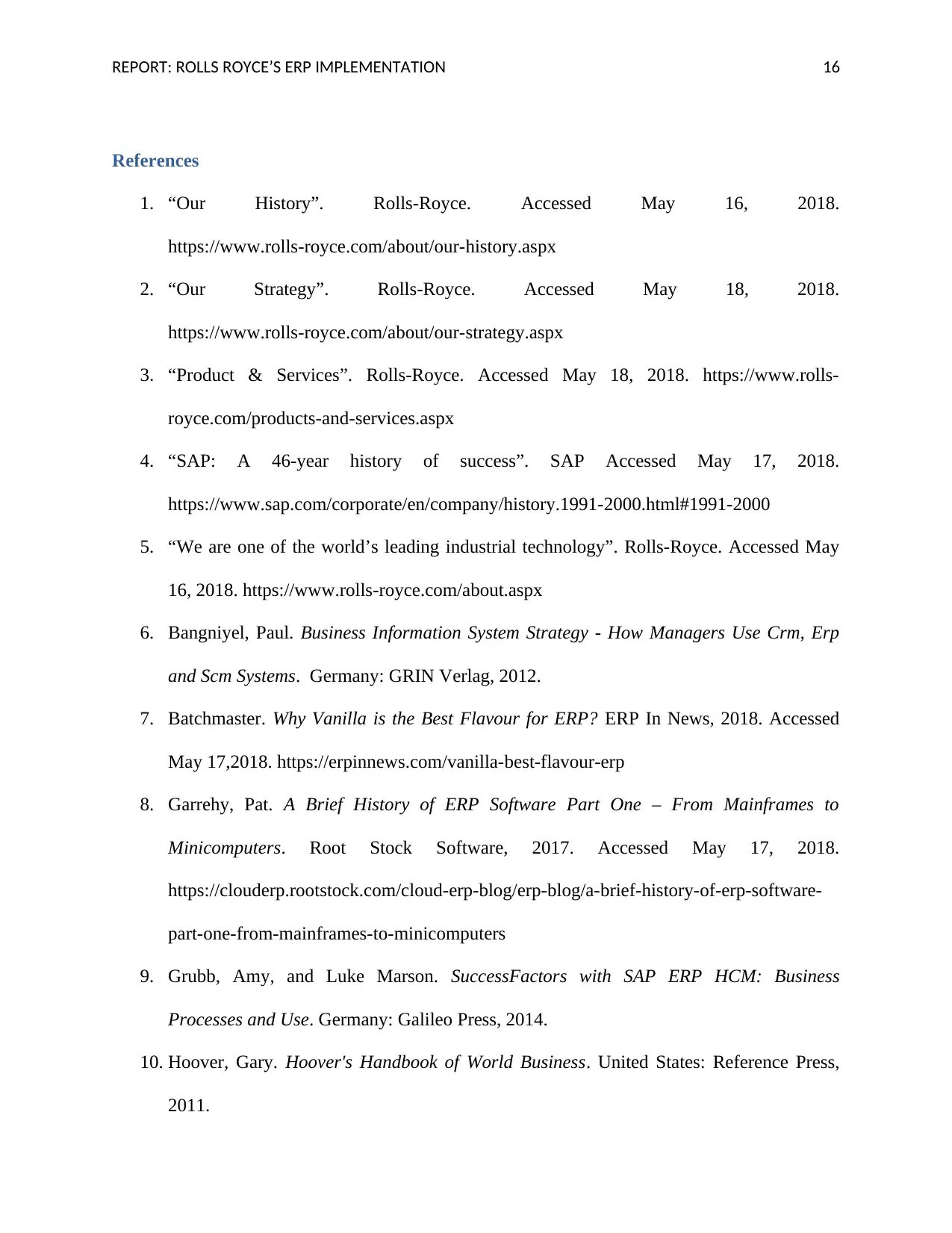
REPORT: ROLLS ROYCE’S ERP IMPLEMENTATION 16
References
1. “Our History”. Rolls-Royce. Accessed May 16, 2018.
https://www.rolls-royce.com/about/our-history.aspx
2. “Our Strategy”. Rolls-Royce. Accessed May 18, 2018.
https://www.rolls-royce.com/about/our-strategy.aspx
3. “Product & Services”. Rolls-Royce. Accessed May 18, 2018. https://www.rolls-
royce.com/products-and-services.aspx
4. “SAP: A 46-year history of success”. SAP Accessed May 17, 2018.
https://www.sap.com/corporate/en/company/history.1991-2000.html#1991-2000
5. “We are one of the world’s leading industrial technology”. Rolls-Royce. Accessed May
16, 2018. https://www.rolls-royce.com/about.aspx
6. Bangniyel, Paul. Business Information System Strategy - How Managers Use Crm, Erp
and Scm Systems. Germany: GRIN Verlag, 2012.
7. Batchmaster. Why Vanilla is the Best Flavour for ERP? ERP In News, 2018. Accessed
May 17,2018. https://erpinnews.com/vanilla-best-flavour-erp
8. Garrehy, Pat. A Brief History of ERP Software Part One – From Mainframes to
Minicomputers. Root Stock Software, 2017. Accessed May 17, 2018.
https://clouderp.rootstock.com/cloud-erp-blog/erp-blog/a-brief-history-of-erp-software-
part-one-from-mainframes-to-minicomputers
9. Grubb, Amy, and Luke Marson. SuccessFactors with SAP ERP HCM: Business
Processes and Use. Germany: Galileo Press, 2014.
10. Hoover, Gary. Hoover's Handbook of World Business. United States: Reference Press,
2011.
References
1. “Our History”. Rolls-Royce. Accessed May 16, 2018.
https://www.rolls-royce.com/about/our-history.aspx
2. “Our Strategy”. Rolls-Royce. Accessed May 18, 2018.
https://www.rolls-royce.com/about/our-strategy.aspx
3. “Product & Services”. Rolls-Royce. Accessed May 18, 2018. https://www.rolls-
royce.com/products-and-services.aspx
4. “SAP: A 46-year history of success”. SAP Accessed May 17, 2018.
https://www.sap.com/corporate/en/company/history.1991-2000.html#1991-2000
5. “We are one of the world’s leading industrial technology”. Rolls-Royce. Accessed May
16, 2018. https://www.rolls-royce.com/about.aspx
6. Bangniyel, Paul. Business Information System Strategy - How Managers Use Crm, Erp
and Scm Systems. Germany: GRIN Verlag, 2012.
7. Batchmaster. Why Vanilla is the Best Flavour for ERP? ERP In News, 2018. Accessed
May 17,2018. https://erpinnews.com/vanilla-best-flavour-erp
8. Garrehy, Pat. A Brief History of ERP Software Part One – From Mainframes to
Minicomputers. Root Stock Software, 2017. Accessed May 17, 2018.
https://clouderp.rootstock.com/cloud-erp-blog/erp-blog/a-brief-history-of-erp-software-
part-one-from-mainframes-to-minicomputers
9. Grubb, Amy, and Luke Marson. SuccessFactors with SAP ERP HCM: Business
Processes and Use. Germany: Galileo Press, 2014.
10. Hoover, Gary. Hoover's Handbook of World Business. United States: Reference Press,
2011.
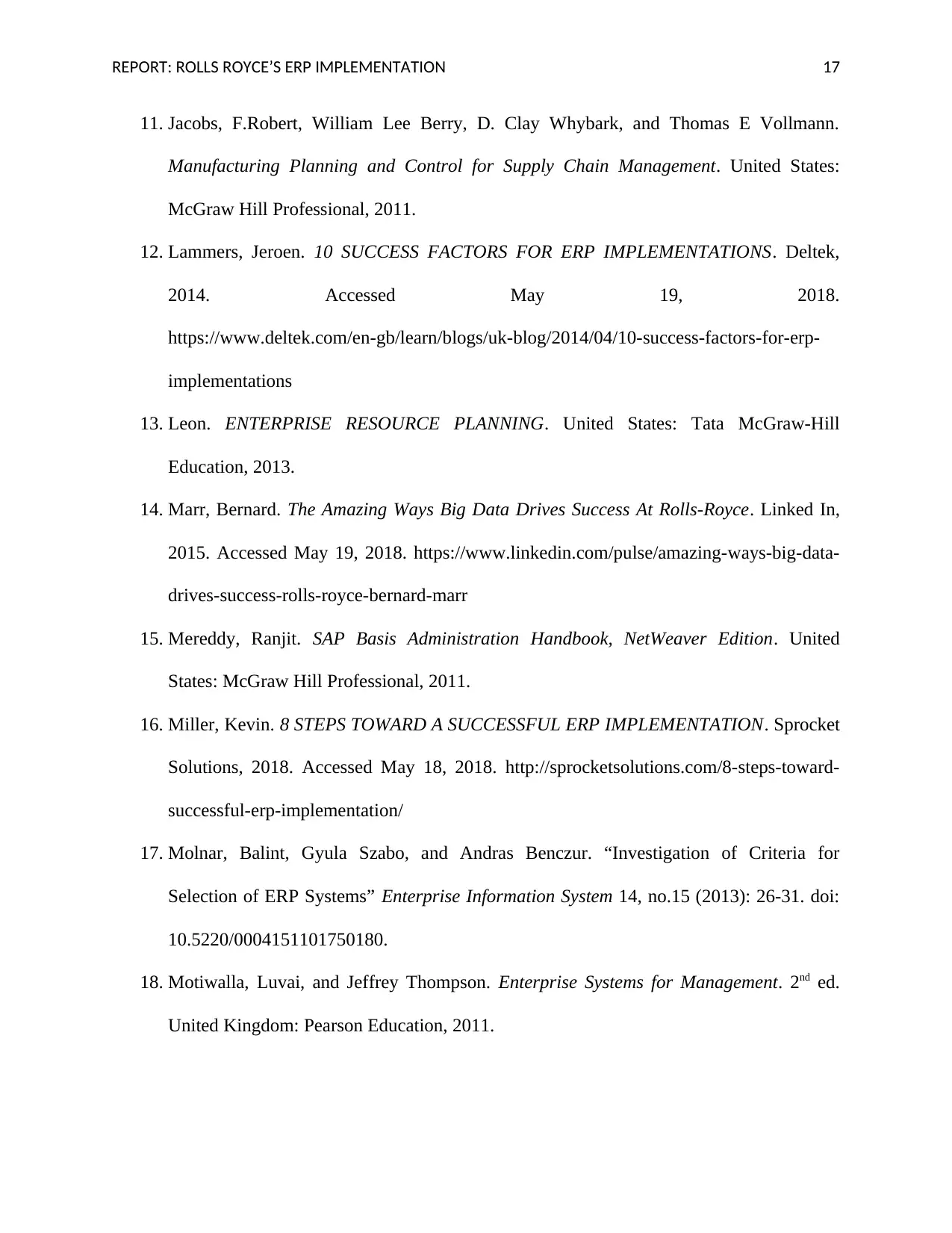
REPORT: ROLLS ROYCE’S ERP IMPLEMENTATION 17
11. Jacobs, F.Robert, William Lee Berry, D. Clay Whybark, and Thomas E Vollmann.
Manufacturing Planning and Control for Supply Chain Management. United States:
McGraw Hill Professional, 2011.
12. Lammers, Jeroen. 10 SUCCESS FACTORS FOR ERP IMPLEMENTATIONS. Deltek,
2014. Accessed May 19, 2018.
https://www.deltek.com/en-gb/learn/blogs/uk-blog/2014/04/10-success-factors-for-erp-
implementations
13. Leon. ENTERPRISE RESOURCE PLANNING. United States: Tata McGraw-Hill
Education, 2013.
14. Marr, Bernard. The Amazing Ways Big Data Drives Success At Rolls-Royce. Linked In,
2015. Accessed May 19, 2018. https://www.linkedin.com/pulse/amazing-ways-big-data-
drives-success-rolls-royce-bernard-marr
15. Mereddy, Ranjit. SAP Basis Administration Handbook, NetWeaver Edition. United
States: McGraw Hill Professional, 2011.
16. Miller, Kevin. 8 STEPS TOWARD A SUCCESSFUL ERP IMPLEMENTATION. Sprocket
Solutions, 2018. Accessed May 18, 2018. http://sprocketsolutions.com/8-steps-toward-
successful-erp-implementation/
17. Molnar, Balint, Gyula Szabo, and Andras Benczur. “Investigation of Criteria for
Selection of ERP Systems” Enterprise Information System 14, no.15 (2013): 26-31. doi:
10.5220/0004151101750180.
18. Motiwalla, Luvai, and Jeffrey Thompson. Enterprise Systems for Management. 2nd ed.
United Kingdom: Pearson Education, 2011.
11. Jacobs, F.Robert, William Lee Berry, D. Clay Whybark, and Thomas E Vollmann.
Manufacturing Planning and Control for Supply Chain Management. United States:
McGraw Hill Professional, 2011.
12. Lammers, Jeroen. 10 SUCCESS FACTORS FOR ERP IMPLEMENTATIONS. Deltek,
2014. Accessed May 19, 2018.
https://www.deltek.com/en-gb/learn/blogs/uk-blog/2014/04/10-success-factors-for-erp-
implementations
13. Leon. ENTERPRISE RESOURCE PLANNING. United States: Tata McGraw-Hill
Education, 2013.
14. Marr, Bernard. The Amazing Ways Big Data Drives Success At Rolls-Royce. Linked In,
2015. Accessed May 19, 2018. https://www.linkedin.com/pulse/amazing-ways-big-data-
drives-success-rolls-royce-bernard-marr
15. Mereddy, Ranjit. SAP Basis Administration Handbook, NetWeaver Edition. United
States: McGraw Hill Professional, 2011.
16. Miller, Kevin. 8 STEPS TOWARD A SUCCESSFUL ERP IMPLEMENTATION. Sprocket
Solutions, 2018. Accessed May 18, 2018. http://sprocketsolutions.com/8-steps-toward-
successful-erp-implementation/
17. Molnar, Balint, Gyula Szabo, and Andras Benczur. “Investigation of Criteria for
Selection of ERP Systems” Enterprise Information System 14, no.15 (2013): 26-31. doi:
10.5220/0004151101750180.
18. Motiwalla, Luvai, and Jeffrey Thompson. Enterprise Systems for Management. 2nd ed.
United Kingdom: Pearson Education, 2011.

REPORT: ROLLS ROYCE’S ERP IMPLEMENTATION 18
19. R. Amir, Amir, and Stanley I. Weiss. Rolls-Royce PLC. Britannica, 2018. Accessed May
17, 2018. https://www.britannica.com/topic/Rolls-Royce-PLC
20. Yusuf, Yahaya, A Gunasekaran, and Mark S Abthorpe. 2004. “Enterprise information
systems project implementation:: A case study of ERP in Rolls-Royce” International
Journal of Production Economics 87 (3): 251-256. doi:10.1016/j.ijpe.2003.10.004.
19. R. Amir, Amir, and Stanley I. Weiss. Rolls-Royce PLC. Britannica, 2018. Accessed May
17, 2018. https://www.britannica.com/topic/Rolls-Royce-PLC
20. Yusuf, Yahaya, A Gunasekaran, and Mark S Abthorpe. 2004. “Enterprise information
systems project implementation:: A case study of ERP in Rolls-Royce” International
Journal of Production Economics 87 (3): 251-256. doi:10.1016/j.ijpe.2003.10.004.
1 out of 19
Related Documents
Your All-in-One AI-Powered Toolkit for Academic Success.
+13062052269
info@desklib.com
Available 24*7 on WhatsApp / Email
![[object Object]](/_next/static/media/star-bottom.7253800d.svg)
Unlock your academic potential
© 2024 | Zucol Services PVT LTD | All rights reserved.




